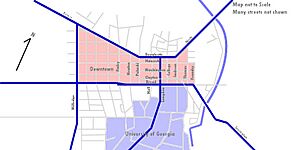Downtown Athens (Georgia) facts for kids
Downtown Athens is a very old and important part of Athens, a city in Georgia, United States. It's where many businesses, shops, and homes are located. People often think of Downtown as the area between Dougherty Street (north), Broad Street and the University of Georgia campus (south), Pulaski Street (west), and Foundry Street (east).
A special area called the Downtown Athens Historic District was recognized in 1978. This means it has important old buildings and history.
The main part of the city, with its businesses and government offices, has always been towards the eastern side of Downtown. Recently, new buildings and shops have expanded the "central" part of this neighborhood. When people talk about Downtown Athens for fun, like nightlife and restaurants, they usually mean this smaller, busy area.
Some people also include the area west of Pulaski Street when they talk about "Downtown." This part has many historic homes, new houses, and some public housing. You'll find the most hotels here, especially along Broad Street. The Prince Avenue area is also a key business spot, especially for people living in the Boulevard and Normaltown neighborhoods.
There are several hotels and apartment buildings in Downtown Athens. More tall condo buildings are being built or planned. These new buildings, along with a new transportation center, could make Downtown Athens stretch even further east, all the way to the Oconee River.
What is "Downtown Athens"?
The exact borders of "Downtown" can change depending on why you're talking about it. Here are some common ways people define it:
| South Side | North Side | East Side | West Side | What it's used for |
|---|---|---|---|---|
| Broad St | Hancock St | Foundry St | Pulaski St | This is the "no-cruising zone" for cars. It means cars can't pass the same spot more than three times in an hour, from midnight to 4 a.m. |
| Broad St | Dougherty St | Foundry St | Pulaski St | This is the most common idea of Downtown. It stands out with many buildings and paid street parking. Athens-Clarke County uses special street signs with their logo in this area. |
| Broad St | Dougherty St/ Prince Ave | Foundry St | Milledge Ave | This is a larger idea of Downtown. It includes the main area plus the Broad Street and Prince Avenue areas just west of the core. |
Downtown Athens: A Cultural Hub
Downtown Athens is the heart of the city's culture. Many nightclubs here host local, regional, and national bands and artists. The 40 Watt Club and Georgia Theater are very famous. Many bands became well-known after playing at these spots (check out Music of Athens, Georgia to learn more). A book called Cool Town (published in 2020) talks about the indie music scene in Athens during the 1980s.
The Classic Center is a large building on Thomas Street. It has a performing arts center, convention spaces, and big rooms for events. It was even used to film parts of the TV show Blue Collar TV.
Delicious Dining Options
Downtown Athens has many amazing restaurants. Five & Ten is a well-known restaurant with a famous chef named Hugh Acheson. He was named Best Chef Southeast by the James Beard Foundation and appeared on a TV show called Top Chef: Masters (season 3).
You can find all kinds of food here. There are fancy, expensive restaurants, popular chain restaurants, places with food from different countries, and even cheap bar food.


